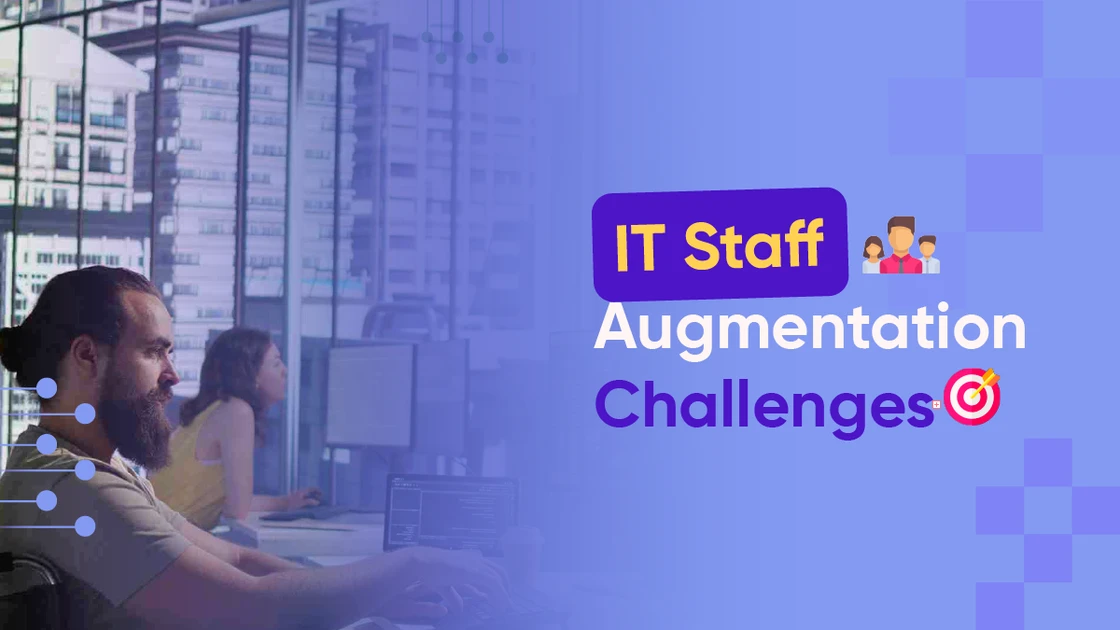The pace of business today leaves little room for delays because markets change overnight, competitors release new features faster, and customer expectations keep rising. One month, you have enough in-house talent to handle everything; the next month, you’re racing to deliver a new product, fix a security gap, or launch an MVP in a new segment.
In those moments, traditional hiring can feel painfully slow. That is why many companies turn to IT staff augmentation, which can help you bring in niche professionals exactly when you need them.
Key Challenges in IT Staff Augmentation
But while the benefits are strong, the road isn’t always smooth, as it comes with IT staff augmentation challenges at any stage, such as blending new people into your culture, working across time zones, or protecting sensitive data.
Here are some common challenges you may face when hiring experts and how to overcome them.
1. Difficulty in Finding Niche Tech Talent
One of the main challenges businesses face is finding tech professionals with the right expertise to meet their needs. Niche roles like Numpy experts, AI developers, UI/UX designers, and React Native specialists are in high demand with a short supply. Companies may spend months trying to fill these positions, which can slow down projects and delay product launches.
Solution: Choose a trusted staff augmentation company that provides pre-screen talent, use specialized job boards and professional communities, and run skills-based tests to see how candidates will perform in real scenarios.
2. Managing Evolving Project Requirements
IT projects rarely stay the same. Scope changes, new feature requests, or shifting priorities happen often, and if they aren’t managed carefully, they can cause chaos. Teams may fall behind schedule or work on outdated requirements, which can lead to a waste of time and effort
Solution: Start by clearly defining the project scope, milestones, and deliverables. Use agile practices like sprint planning and backlog grooming to stay flexible and adapt quickly. Keep a detailed record, “change log” to track all modifications, approvals, and the proper reasoning behind each decision made throughout the project.
3. Protecting Data while Ensuring Compliance
Working with external staff increases the risk of exposing company data. Handling sensitive business or customer information can be challenging, especially under regulations like GDPR, HIPAA, or SOC 2, where errors could lead to security breaches or legal issues.
Solution: When you work with augmented staff, you should require them to sign NDAs and only give them access to the information they need. To keep things safe and build trust, use secure communication, like VPNs and two-factor authentication.
4. Overcoming Time-Zone and Scheduling Barriers
Global teams offer access to a diverse talent pool, but time-zone differences create real challenges. Limited overlap can delay critical decisions, slow down communication, and make real-time problem-solving difficult.
Solution: To keep a global team in sync, establish core working hours, rotate meeting times, and use asynchronous updates. Collaborating with a company that provides augmented staff according to your time zone can also be helpful.
Example: A US fintech company set 3-hour overlap windows with its Eastern European team and accelerated project delivery by 20%, which sets an example that staff augmentation is reshaping US tech dynamics.
5. The Vulnerability of Single-Vendor Dependence
Relying heavily on a single staffing partner creates vulnerability. If the vendor cannot deliver, delays occur, or costs rise unexpectedly. Companies may struggle to scale teams quickly when needed.
Solution: Maintain relationships with multiple vetted vendors, keep a small bench of backup augmented staff, and negotiate flexible contracts that allow scaling resources up or down.
6. Finding Good Quality without High Costs
Many companies face the temptation to onboard augmented staff at the lowest possible rate. But low cost often comes at the expense of quality, resulting in rework, delayed timelines, and frustration.
Solution: Evaluate vendors based on experience and past results, request case studies or references, and define budget and expectations clearly from day one.
7. Integrating Augmented Staff into Existing Team
Augmented staff may use different tools or follow different processes and strategies for their work, which makes it challenging to integrate them smoothly into the existing team and workflows. This can slow down project progress and lead to missed due dates or duplicated work..
Solution: Provide access to documentation, tools, and workflow instructions immediately and plan daily standups to maintain project control.
8. Measuring Staff Performance and Engagement
Managing remote or augmented teams can be tricky. And what’s tough is to monitor performance without micromanaging, which can lead to its own set of problems. When staff feel disconnected or disengaged, they may miss deadlines, potentially resulting in inconsistent work.
Solution: Focus on results rather than hours worked, check in regularly to understand challenges, and recognize achievements to maintain motivation. Monthly “pulse checks” can help spot engagement issues early.
9. Planning for Project Completion and Knowledge Transfer
When the project ends, valuable knowledge, code, and processes can be lost if not properly transferred. Lack of planning for project closure can result in post-project confusion and delays.
Solution: Include regular knowledge transfer sessions within contracts, document processes and decisions thoroughly, and give augmented staff sufficient notice to conclude the tasks accordingly.
Example: A SaaS company scheduled a two-week overlap between outgoing augmented staff and in-house staff, ensuring a smooth handover and avoiding weeks of troubleshooting.
Why You Should Choose IT Staff Augmentation?
Companies can bring in specialized talent faster, scale teams up or down when needed, manage costs better, and keep projects on track without putting extra pressure on their in-house team. With the right approach and knowing the benefits of IT staff augmentation, businesses can tackle common challenges.
1. Access to Skilled Experts
IT staff augmentation gives you access to highly specialized talent without going through long hiring cycles. Whether you want to onboard PHP developers who have familiarity with Laravel or hire JavaScript developers with website development knowledge, you can bring in experts exactly when you need them.
2. Faster Hiring
Traditional hiring can take 30–90 days or more, but staff augmentation allows you to onboard professionals in as little as 48 to 72 hours. You can quickly strengthen your team when deadlines loom, keeping projects on track and reducing bottlenecks.
3. Cost Control
With IT staff augmentation, you only pay for the skills you need. There’s no need to cover long-term salaries, benefits, or overhead costs. For many projects, this can save up to 85% compared to hiring full-time employees, letting you allocate budget to other critical areas.
4. Scalability
Workloads fluctuate, and projects often demand extra hands temporarily. Staff augmentation allows businesses to expand their team when demand is high and scale down once the work is done. This flexibility keeps costs under control while maintaining efficiency.
5. Faster Time to Market
Bringing in experts quickly means your products and services can reach the market sooner. With specialized skills on demand, projects move faster, testing and deployment happen on schedule, and you can stay ahead of competitors.
Top IT Staff Augmentation Service Providers
Selecting the right company can make a big difference in tackling IT staff augmentation challenges. Businesses often face fluctuating workloads, but working with a reliable provider gives you skilled talent and helps integrate them smoothly into your workflow, keeping projects on track and aligned with your business objectives.
1. Crewmate by Squareboat
Crewmate by Squareboat helps businesses expand their teams with carefully selected developers and IT specialists. Their focus on speed, flexibility, and seamless integration allows companies to scale their personnel based on project needs. They offer a 7-day free trial, quick and easy onboarding within 48 hours
They also ensure a fast and easy replacement, minimizing disruptions. Their professionals can work remotely or on-site, giving businesses the ability to choose the setup that best fits their workflow. Crewmate helps reduce bottlenecks and ensures projects stay on track efficiently, all under budget.
2. Toptal
Toptal is known for its exclusive network of elite professionals. They carefully screen and accept only the top 3% of applicants, which gives businesses access to highly skilled software engineers, designers, and project managers.
Their service comes with premium pricing, reflecting the experience and quality of their talent.
3. Upwork
Upwork is a front-running platform for finding freelance IT professionals quickly. It provides availability to a vast range of skills and experience levels, from junior developers to senior specialists. The platform supports flexible engagement—whether for short-term projects, long-term contracts, or full-time remote roles.
It’s ideal for companies that need rapid scaling or specialized skills, offering a practical solution to common business challenges while keeping projects on record.
While the talent pool is vast, it may take some time to identify the most experienced professionals for highly specialized roles.
Key Trends in IT Staff Augmentation
As companies strive to grow their teams quickly and keep up with fast-moving project needs, they often face IT staff augmentation challenges, like securing the right skills, managing remote workers, and maintaining productivity.
To overcome these hurdles, several key trends are shaping businesses to successfully use IT staff augmentation to stay agile and deliver results. These approaches form several key trends that are reshaping how companies build and manage their IT teams.
Conclusion
IT staff augmentation goes beyond temporary hiring—it’s a strategy to keep your business agile in a fast-moving market. While IT staff augmentation challenges like finding specialized talent, bridging cultural gaps, or ensuring data security can arise, they are manageable with the right planning and trusted companies
By bringing in the right experts at the right time, scaling teams without friction, and integrating them into existing workflows, businesses can accelerate projects, stay ahead of competition, and transform short-term support into long-term growth.
Frequently Asked Questions
Q. How can I maintain cost efficiency while hiring skilled augmented staff?
You can maintain cost efficiency by clearly defining project scope, selecting vendors with proven results, and using flexible contracts to scale teams as needed. Avoiding low-cost, low-quality talent prevents rework and delays, ensuring projects/tasks are delivered within budget and time.
Q. How do I choose between freelance work and contract-based staff augmentation?
When deciding between freelance work and contract-based staff augmentation, consider the project’s needs. Freelance work is best for short-term or simple projects that require flexibility and quick hires. Contract-based staff augmentation provides pre-screened professionals, structured onboarding, and quality assurance, making it more suitable for complex or critical projects. Your choice should depend on the project’s complexity, required expertise, and timeline.
Q. Can IT staff augmentation challenges impact client satisfaction?
Yes, they can have a significant effect. When augmented staff miss deadlines, deliver inconsistent work, or fail to meet quality expectations, it can directly impact the products or services delivered to clients. This may lead to rework and ultimately dissatisfaction from clients who expect timely and reliable results.


